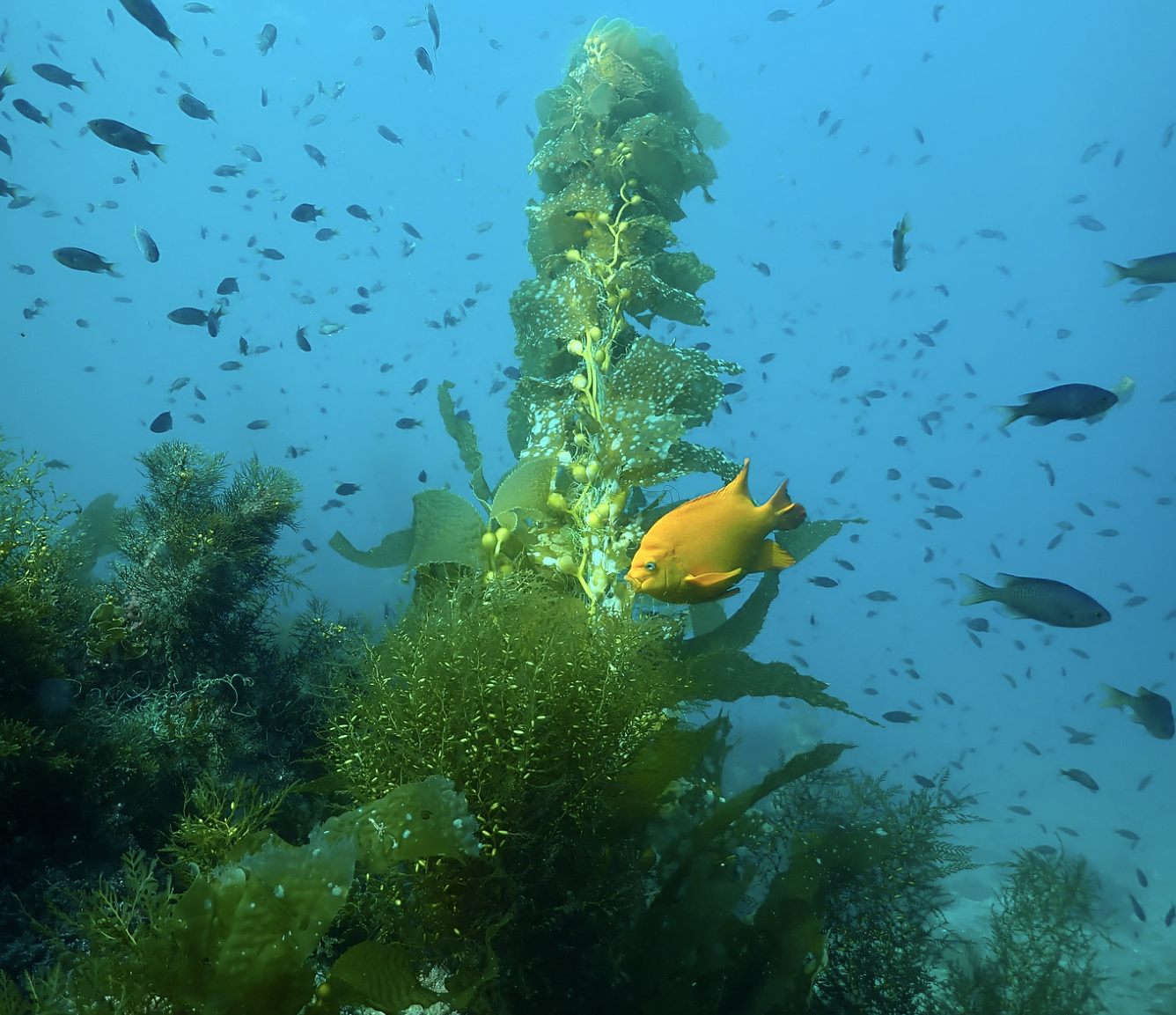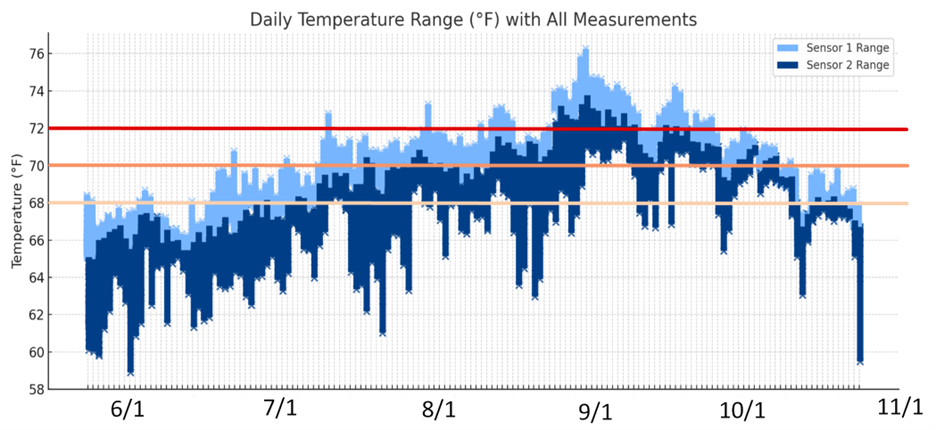Kelp Stress: When the Ocean Heats Up
In our last post, we introduced the Sofar Spotter Buoy installed off CIMI — a powerful tool for monitoring wave energy, temperature, and surface conditions that influence kelp forest growth and recovery. Since then, the buoy’s dual temperature sensors have been quietly recording the rhythm of the ocean — from the sun-warmed surface to the cooler depths below.
In this update, we take a closer look at what that data reveals about temperature thresholds that matter to kelp and explore how these shifts ripple through the ecosystem — from kelp senescence (deterioration) to carbon cycling and the feeding of invertebrate filter feeders.
Tracking Change from Surface to Seafloor
The Spotter buoy records temperature hourly at two depths:
Sensor 1 records temperature at 1 meter, just below the surface where conditions shift quickly with sunlight and wind.
Sensor 2 records temperature at 10 meters, around where the kelp attaches to the seafloor.
The graph above highlights clear differences between surface and bottom waters. During the summer months, the shallow sensor often crossed above 68°F — a critical physiological threshold for giant kelp (Macrocystis pyrifera). Prolonged exposure above this level can trigger senescence, the process where kelp begins to slow its growth, lose tissue integrity, and eventually die back.
The graph above presents the data a little differently, rather than showing daily averages, it shows the range of temperatures collected hourly for each day. As you can see, the temperature fluctuations each day can be significant. Sensor 2, at 10 m, receives periodic pulses of cooler, nutrient-rich waters.
Counting the Warm Days
To understand how stressful this warm period was for kelp, we looked at the number of days each sensor recorded temperatures above 68°F.
At 1 meter, the water remained above this threshold for much of July through mid-October — a sustained warm period that would have placed significant stress on kelp fronds in shallower waters and near the surface.
At 10 meters, temperatures were cooler but still reached 68°F a significant amount of the time, offering a slight refuge for deeper kelp blades and juvenile kelp.
This contrast shows how vertical thermal structure — the difference between shallow and deep water — can influence which parts of a kelp forest persists through warm seasons and which are most vulnerable.
With each increasing degree above 68°F, the toll on the kelp increases significantly.
of the kelp senescing in August when the water temperature was 72°F.
When Kelp Declines, Carbon Flows
As kelp begins to senesce in warm water, it releases organic carbon back into the environment. Some of that carbon becomes dissolved organic matter, fueling microbial growth, while larger fragments break off and become particulate detritus.
This detrital carbon doesn’t vanish — it flows through the ecosystem in two main ways:
Seafloor export: Fragments sink, where they may be buried or consumed by bottom-dwelling organisms, contributing to longer-term carbon storage.
Local recycling: Microbes, detritivores (e.g. sea urchins, brittle stars), and filter-feeding invertebrates — such as sponges, tunicates, and bivalves — consume the organic particles and convert them back into biomass that supports higher trophic levels.
In this way, even as warm water slows kelp growth, the carbon it releases fuels other life — illustrating how tightly connected physical, chemical, and biological processes are in nearshore ecosystems.
Filter Feeders: The Quiet Beneficiaries
During senescence events, fine organic particles from decaying kelp drift through the water column like marine snow. Filter feeders capture these particles, deriving energy from the breakdown products of kelp productivity.
Short warm spells can therefore act as carbon pulses — brief periods of increased food availability for invertebrate communities. However, if warm conditions persist for too long, the balance tips: less kelp growth means less long-term carbon input, leading to lower overall productivity across the food web.
Why This Matters for Restoration
For restoration scientists, this temperature data provides both a warning and a roadmap:
Timing matters: Restoration efforts that involve outplanting kelp are most successful before warm periods begin, giving kelp time to anchor and grow strong.
Depth matters: Cooler, deeper reefs can offer thermal refuges that support persistence through late-summer heat.
Ecosystem perspective matters: Even when kelp declines, the carbon it releases continues to support marine life — a reminder that restoration is not just about kelp, but about sustaining the complex food web it supports.
By linking real-time temperature monitoring to ecological responses, CIMI’s kelp restoration project continues to illuminate how climate variability shapes coastal ecosystems — and how data can guide more resilient management decisions.
Looking Ahead
The buoy will continue transmitting data through the fall, winter, and into next year, capturing the seasonal cooling that often precedes new kelp recruitment. In future posts, we’ll explore how these temperature transitions align with kelp spore settlement and early recruitment, closing the loop between physical conditions, biological response, and restoration outcomes.
Thank you to the
Kansas City Zoo and Aquarium
for their generous grant support to purchase the Spotter Buoy!







